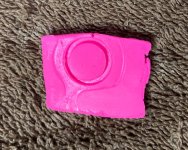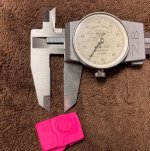ezb57
Member
Thanks for your great reply. I used clay to get an impression of the FC and then carefully measured that. I feel that this was quite accurate.As WR Moore mentioned forcing cones can have a larger diameter (.377") than that.
I don't know how you measured your F-C opening but if you didn't use a cylindrical gage it may not be accurate?
Since typical pin gages are 2" long they can't be used because they're too long to fit in the cylinder's window.
I did not buy any of Brownell's barrel chamfering plug gages but rather used a fired case from the revolver as a gage in the F-C mouth. Some flaring/bell-mouthing of the case may be necessary to reach the desired case mouth diameter. It's cheaper & gets you in the ballpark.
This is from Brownell's instruction pamphlet on their Revolver Chamfering Tool Kit:
When cutting a chamfer, you normally do not want to have the internal diameter of the rear-most portion of the chamfered area to be over .020" larger than the diameter of the bullet of the cartridge that is being used. In other words, in a .38 Special revolver, which utilizes a bullet that is normally .356" to .358" in diameter, the maximum diameter of the chamfer should be .376" to .378". A very simple and easy way to check this, and to ensure you do not cut more than you should, is to utilize the Brownells Chamfer Plug Gauges. By using these Gauges, you can tell at a glance exactly how deep a cut should be. Above all, be extremely careful when cutting with this tool. It is very easy to cut too much. Go slow! Be careful!
.
As for your question about a range rod again it's an item I've never bought. Since I have several sets of pin gages I just use a slightly smaller pin gage then largest gage that can freely fit down the barrel's (clean) muzzle/barrel & tip the muzzle slightly up to allow the gage to slide down the barrel & into the cylinder noticing if it passes the B-C gaps without interference or hanging up there.
.
Until I can rule out cylinder misalignment, I will hold off on any attempt to alter the FC profile and finish.
Thanks again


